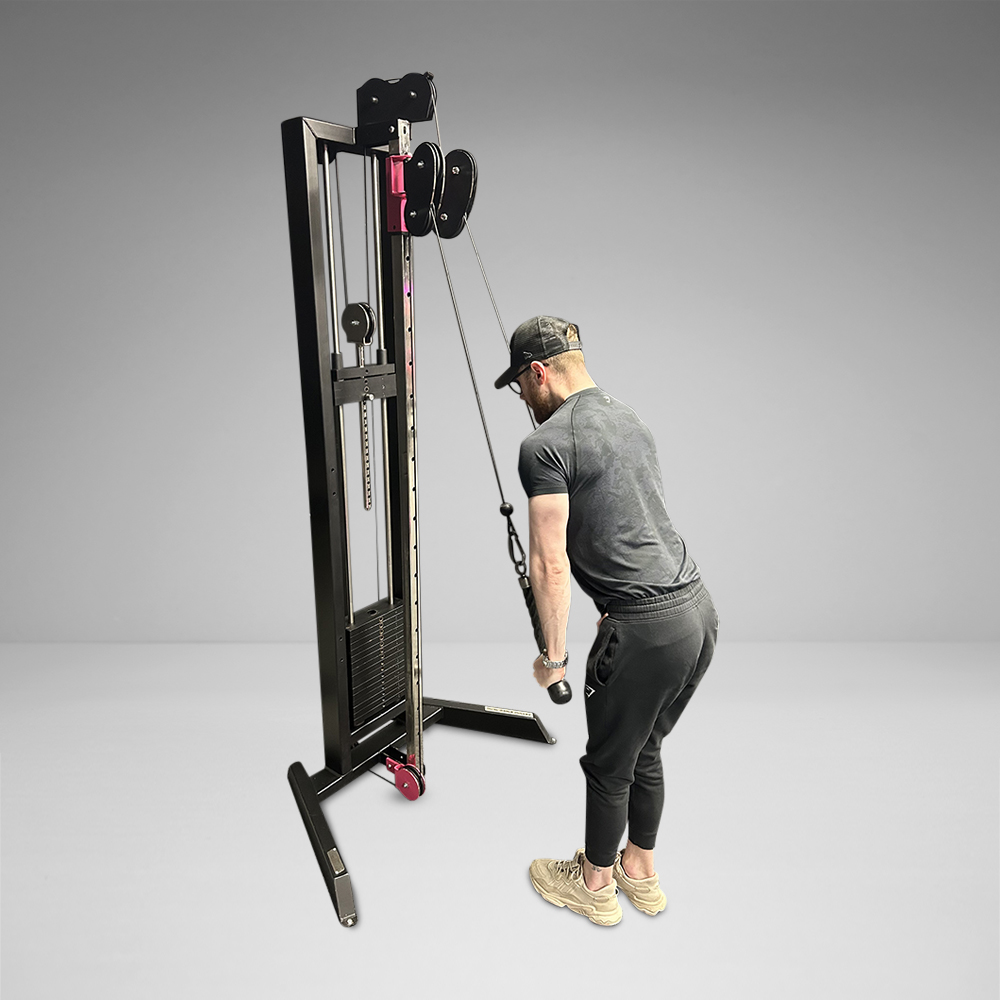Exercise equipment with pulleys offers versatile and effective workouts. They help target various muscle groups through adjustable resistance.
Pulleys in exercise equipment bring flexibility to workout routines. Users can perform a wide range of exercises, focusing on strength, flexibility, and endurance. This equipment allows smooth and controlled movements, reducing the risk of injury. Machines with pulleys, such as cable crossover stations and functional trainers, provide resistance that can be easily adjusted to match fitness levels.
This adaptability makes them suitable for beginners and advanced users. Compact designs of pulley-based machines make them ideal for home gyms, saving space while offering comprehensive workout options. Investing in pulley-equipped exercise machines enhances overall fitness and promotes a balanced workout regimen.

Credit: watsongym.co.uk
Introduction To Pulley Systems
Exercise equipment with pulleys offers versatile workout options. These systems provide resistance and improve strength. Learn about the benefits and features of pulley systems below.
What Are Pulley Systems?
Pulley systems use wheels and ropes to create resistance. They are common in many gym machines. Pulleys help lift weights and improve muscle strength.
These systems often have adjustable settings. This allows users to change the resistance level. Pulleys are great for both beginners and advanced users.
Benefits Of Pulley Equipment
- Versatility: Pulleys can target various muscle groups.
- Adjustable Resistance: Change the weight to suit your strength.
- Safety: Reduced risk of injury compared to free weights.
- Compact Design: Many pulley machines fit in small spaces.
- Rehabilitation: Ideal for physical therapy and recovery.
| Feature | Description |
|---|---|
| Adjustable Resistance | Change weight levels easily. |
| Multiple Attachments | Handles, bars, and more for different exercises. |
| Compact Design | Fits in small home gyms. |
Types Of Pulley Equipment
Exercise equipment with pulleys offers diverse workout options. They help improve strength, flexibility, and balance. Below are popular types of pulley equipment.
Cable Machines
Cable machines are versatile and adjustable. They provide resistance through cables and pulleys. These machines are ideal for various exercises.
- Chest Press
- Lat Pulldown
- Bicep Curls
- Tricep Extensions
Benefits of cable machines include:
- Adjustable weight stacks
- Multiple attachment options
- Full range of motion
They are perfect for both beginners and advanced users.
Functional Trainers
Functional trainers focus on multi-directional movements. They simulate real-life activities, enhancing overall fitness.
Key features of functional trainers:
- Dual adjustable pulleys
- Wide range of exercises
- Customizable resistance
Popular exercises include:
- Woodchoppers
- Squat to Press
- Single Arm Row
- Core Twists
Functional trainers are excellent for strength and functional fitness training.
Choosing The Right Pulley System
Choosing the right pulley system can be tricky. Different pulley systems have unique features. Your choice affects your workout quality. To help, let’s explore key factors like space and budget.
Space Considerations
Space matters a lot when picking a pulley system. Small apartments need compact equipment. A foldable or wall-mounted pulley system works best. These options save space and are easy to store.
- Foldable systems fit in small spaces.
- Wall-mounted systems save floor space.
- Portable systems are easy to move.
Large homes can accommodate bigger setups. Consider a full gym setup if you have space. These offer more exercise options. They are also sturdier and more durable.
Budget-friendly Options
A tight budget shouldn’t limit your fitness goals. Affordable pulley systems are available. Some low-cost options perform well. They offer good value for money.
Here are some budget-friendly options:
- Resistance band pulley systems are cheap.
- DIY pulley setups can save money.
- Second-hand equipment offers great deals.
Invest in quality even on a budget. Cheap but sturdy equipment lasts longer. It provides a better workout experience. Always read reviews before buying.
| Type | Space Needed | Price Range |
|---|---|---|
| Foldable | Small | $50 – $150 |
| Wall-Mounted | Minimal | $100 – $300 |
| Full Gym Setup | Large | $500 – $2000 |
Choose wisely to get the best value. Your fitness journey depends on it. With the right pulley system, you can achieve your goals.

Credit: m.youtube.com
Installing Pulley Equipment
Installing pulley equipment in your home gym can be rewarding. This guide will help you set up your equipment correctly. Follow these steps for a safe and effective installation.
Mounting Techniques
Proper mounting is crucial for pulley equipment. First, choose a strong wall for mounting. Concrete walls are ideal. Use a stud finder to locate wall studs. Mark the spots where you will drill.
Drill holes with the right size bit. Insert heavy-duty anchors into the holes. Attach the mounting brackets securely with screws. Ensure the brackets are level. Use a spirit level to check.
Safety Precautions
Safety must be your top priority. Check all parts before installation. Look for signs of wear or damage. Replace any faulty parts immediately.
Wear protective gear when drilling. Safety glasses and gloves are essential. Keep children and pets away from the work area. Follow the manufacturer’s instructions carefully.
- Double-check all connections.
- Ensure the equipment is stable.
- Test the pulleys with light weights first.
Regularly inspect your equipment for safety. Tighten any loose screws. Lubricate moving parts as needed.
Exercises With Pulley Systems
Exercise equipment with pulleys offers a versatile workout. They allow for a range of motion and resistance levels. You can perform a variety of exercises targeting different muscle groups. Pulley systems are effective for both strength training and rehabilitation.
Upper Body Workouts
Pulley systems are excellent for upper body workouts. They help in building strength and improving flexibility. Here are some effective exercises:
- Bicep Curls: Stand facing the pulley, grab the handle, and curl your arm upward.
- Tricep Pushdowns: Face the pulley, push the handle down to extend your arm.
- Chest Fly: Stand in the middle, pull the handles together in front of you.
- Lat Pulldown: Sit down, pull the bar down to your chest.
Lower Body Workouts
Lower body workouts can also benefit from pulley systems. These exercises help in strengthening legs and improving balance:
- Leg Curls: Attach the pulley to your ankle, curl your leg backward.
- Leg Extensions: Sit down, attach the pulley to your ankle, extend your leg forward.
- Hip Abductions: Stand sideways to the pulley, lift your leg away from your body.
- Glute Kickbacks: Face the pulley, kick your leg backward.

Credit: www.gymleco.com
Maintaining Pulley Equipment
Proper maintenance of exercise equipment with pulleys ensures its longevity and optimal performance. Regular upkeep can prevent unexpected breakdowns and keep your workouts safe and effective. Let’s explore some essential maintenance practices.
Routine Inspections
Carry out routine inspections to identify wear and tear early. Check cables for fraying or kinking. Examine pulleys for smooth rotation and alignment. Inspect the frame for any signs of rust or damage. A quick visual check can save you from costly repairs.
Lubrication Tips
Lubricate moving parts to ensure smooth operation and reduce friction. Use a silicone-based lubricant on pulleys and cables. Avoid oil-based lubricants as they attract dust and dirt. Follow the manufacturer’s guidelines for lubrication frequency.
Here’s a simple lubrication schedule:
| Component | Frequency | Lubricant Type |
|---|---|---|
| Pulleys | Monthly | Silicone-based |
| Cables | Bi-monthly | Silicone-based |
Always clean parts before applying lubricant. This ensures dirt does not mix with the lubricant.
Advanced Pulley Workouts
Advanced pulley workouts push your limits and elevate your fitness game. These exercises target multiple muscle groups and improve overall strength. Using exercise equipment with pulleys can transform your routine.
High-intensity Routines
High-intensity pulley workouts get your heart pumping. These exercises burn more calories and build muscle fast. Some examples include:
- Chest Flyes: Strengthen your chest and shoulders.
- Lateral Pulldowns: Target your back muscles efficiently.
- Tricep Pushdowns: Tone your triceps and enhance arm definition.
Incorporating Resistance Bands
Adding resistance bands to pulley workouts increases the challenge. This combination boosts muscle engagement and flexibility. Here are some effective exercises:
- Banded Squat Rows: Work your legs and back simultaneously.
- Resisted Chest Press: Improve chest strength and stability.
- Bicep Curls with Bands: Enhance bicep development and grip strength.
Here’s a quick comparison of the benefits:
| Exercise | Muscle Group | Intensity Level |
|---|---|---|
| Chest Flyes | Chest, Shoulders | High |
| Lateral Pulldowns | Back | Medium |
| Tricep Pushdowns | Triceps | High |
| Banded Squat Rows | Legs, Back | High |
| Resisted Chest Press | Chest | Medium |
| Bicep Curls with Bands | Biceps | Medium |
Success Stories And Testimonials
Exercise equipment with pulleys has changed many lives. Success stories and testimonials show their power. Here are real-life transformations and expert opinions.
Real-life Transformations
People share amazing stories about pulley equipment. See how it changed their lives:
- John lost 50 pounds in six months.
- Emma gained strength to lift her grandkids.
- Mike recovered from a knee injury.
John used a pulley system for daily workouts. He combined it with a healthy diet. Emma focused on upper body exercises. She loves playing with her grandkids again. Mike used pulleys for low-impact rehab. His knee feels better now.
Expert Opinions
Experts agree on the benefits of pulley systems. Here are some expert opinions:
| Expert | Opinion |
|---|---|
| Dr. Smith | Pulleys are great for joint-friendly workouts. |
| Coach Jane | They help in building muscle and strength. |
| Physical Therapist Lee | Perfect for injury recovery and flexibility. |
Dr. Smith notes that pulley exercises are easy on joints. Coach Jane finds them effective for muscle growth. Physical Therapist Lee uses them for rehab sessions.
Frequently Asked Questions
What Exercise Equipment Is A Pulley?
A pulley exercise machine often refers to a cable machine or cable crossover. These machines use cables and weights for resistance training, targeting various muscle groups.
What Are The Pulley Machines At The Gym Called?
Pulley machines at the gym are called cable machines or cable crossovers. They offer versatile resistance training options.
What Muscles Does The Pulley Machine Work?
The pulley machine targets various muscle groups. It works the chest, shoulders, back, biceps, triceps, and core muscles. It’s versatile for strength training.
Do Gym Pulleys Reduce Weight?
Yes, gym pulleys reduce weight. They distribute the load, making exercises easier. This helps in lifting heavier weights.
Conclusion
Exercise equipment with pulleys offers versatile and effective workouts. They enhance strength, flexibility, and overall fitness. Ideal for home gyms, these machines are space-saving and user-friendly. Incorporate pulley systems into your routine for a dynamic and engaging exercise experience. Enjoy improved results and a healthier lifestyle with pulley-based equipment.



Leave a Reply